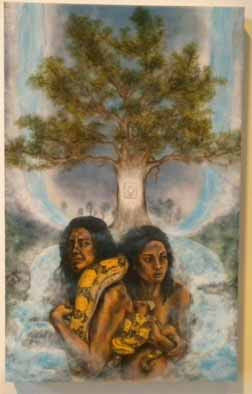I was not one of those who are raving about this movie. I like the concept, I like some of the visuals (and their references to art history, notably "Ophelia" by John Everett Millais ("malaise"?) (and David's "Death of Marat", among others) but this movie gave me a headache. As I write this, I still have a headache. I went into this flick hoping to be transformed. What a disappointment! I'm still the same, but now I have a headache!
The context and emotional landscape are both from the 1950's: in the movies, we had the sci-fi disaster flicks, and on the literary front, we had existentialist philosophy. This really is an existentialist movie, since it deals with the question "how would you live your life if you only had one day to live?" One hopes, as the best existentialist writers said, that you'd approach you situation with courage. This movie reminds me of some of Ingmar Bergman's films, which are also very long, brooding, and about messed up relationships. Here's a clip from Ingmar Bergman's "Persona", so you can get a feel for the mood, pace, and the long drawn out quality...
What "Melancholia" does is puts you in the mindset of someone who has no future (neither does the planet), and forces you to consider how you'd live your last day on Earth. What would you do? You could freakout, and run around in a panic (as do the actors in "As World's Collide"), or you could try to negotiate a dignified exit in a situation in which its impossible to survive. (Here's the trailer for "When World's Collide")
The movie's opening introductory sequence (I'm talking about first 2-3 minutes of the film) are breathtakingly gorgeous. Lots of super slow motion surrealist montage. The beginning of the movie is like a silent short art movie unto itself. It brought tears to my eyes. It was a beautifully lush and graphically surreal portrayal of the disaster which creates the impetus for the film. But after that first opening sequence, your endurance is severely tested.
The movie appears to be set up as a set of pairs: first, and most obviously, is the wedding couple itself: the pair which gets the movie started. Then there are two sisters, two planets (Earth and Melancholia), two halves of the movie (parts 1 & 2, each with it's own screen placard indicating just that, two passes around the Earth by Melancholia as it does it's "Dance Of Death". I'll stay within that tradition, and give this movie... 2 stars (no astronomical pun intended)
I mentioned that this film is part Sci Fi Disaster flick, and part homage to both Ingmar Bergman and Andy Warhol (his short movies that were at the Loft Theater last year). This movie has two winks at Warhol's short films: first, the quick, chopping, whiplash inducing camera work (to remind us that we're watching a film art object, not an illusion of reality). I'm thinking specifically of Warhol's film "My Hustler", which showed at the Loft last year, but which does not appear to be on YouTube. In "Melancholia", as in "My Hustler", the camera is constantly moving around, jerking wildly, as if held by an amateur. I couldn't understand why I was getting car sick watching this flick, but then it dawned on me: it's all of the jerky camera work! I took a break in the lobby shortly after part 2 started, and chatted with one of the guys working at the snack bar. He said that that jerky headache-inducing quality was intentional, so that we could feel the nausea that Kirsten Dunst's character was feeling. I believe him. There's no other good explanation for it. A supporting argument for seeing shades of Warhol in this movie is the presence of Udo Kier, who starred in several of Warhol's later (more polished) movies, such as "Dracula" and "Frankenstein". (Here's a clip of Udo in Warhol's "Dracula", although in "Melancholia", he's an old distinguished looking servant
The trailer for "Melancholia" is very deceptive, since it is fast paced. You get no sense of the long drawn out headache that's about to hit you (Here's the trailer)
Despite this, there are definitely many positive things about this picture: it's got a very intimate feeling; you get a feeling as if you're really spending time with these characters. The topic (i.e. the End of the World) is grim, but it's set against some breathtakingly beautiful scenery. The ugliness actually comes from the people, and their pathetic lives. Nature, and the Cosmos, are Beautiful. People, and their problems, don't quite measure up.
This movie presents you with a thought-experiment: you're getting married on the Earth's Last Day. Would that change your plans at all? It's something to think about. (As this movie suggests, loud grandiose Classical music helps move things along)
(c) 2011 by Howard Salmon
























